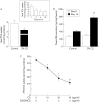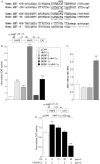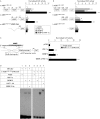Cholesterol dependent downregulation of mouse and human apical sodium dependent bile acid transporter (ASBT) gene expression: molecular mechanism and physiological consequences
- PMID: 16484503
- PMCID: PMC1860007
- DOI: 10.1136/gut.2005.085555
Cholesterol dependent downregulation of mouse and human apical sodium dependent bile acid transporter (ASBT) gene expression: molecular mechanism and physiological consequences
Abstract
Background and aims: Faecal bile acid elimination greatly contributes to cholesterol homeostasis. Synthesised from cholesterol in the liver, bile acids are actively reclaimed in the ileum by the apical sodium dependent bile acid transporter (ASBT). Although the expression level of ASBT affects body cholesterol balance, the impact of cholesterol on ASBT gene expression remains unclear. In this study, the effect of cholesterol on ASBT expression and ileal bile acid uptake was explored in vivo and in vitro.
Methods: ASBT gene expression was assessed by real time quantitative polymerase chain reaction and northern or western blotting, or both, in mice subjected to a 2% cholesterol diet for two weeks, in mouse ileal explants, or in human enterocyte-like Caco-2 cells cultured in sterol enriched or depleted media. Bile acid uptake was determined by measuring [3H]-taurocholic acid influx into in situ isolated ileal loops from mice or into differentiated Caco-2 cells. Molecular analysis of mouse and human ASBT promoters was undertaken with reporter assays, site directed mutagenesis, and electrophoretic mobility shift assays.
Results: In mice, cholesterol enriched diet triggered a downregulation of ASBT expression (mRNA and protein), a fall in ileal bile acid uptake, and a rise in the faecal excretion of bile acids. This effect was direct as it was reproduced ex vivo using mouse ileal explants and in vitro in differentiated Caco-2 cells.
Conclusions: This regulation, which involves an original partnership between SREBP-2 and HNF-1alpha transcription factors, affects ileal bile acid recycling and thus might participate in the maintenance of body cholesterol homeostasis.
Conflict of interest statement
Conflict of interest: None declared.
References
-
- Dietschy J M, Turley S D. Control of cholesterol turnover in the mouse. J Biol Chem 20022773801–3804. - PubMed
-
- Russell D W. The enzymes, regulation, and genetics of bile acid synthesis. Annu Rev Biochem 200372137–174. - PubMed
-
- Gupta S, Pandak W M, Hylemon P B. LXR alpha is the dominant regulator of CYP7A1 transcription. Biochem Biophys Res Commun 2002293338–343. - PubMed
-
- Chiang J Y, Kimmel R, Stroup D. Regulation of cholesterol 7alpha‐hydroxylase gene (CYP7A1) transcription by the liver orphan receptor (LXRalpha). Gene 2001262257–265. - PubMed
Publication types
MeSH terms
Substances
LinkOut - more resources
Full Text Sources
Other Literature Sources






